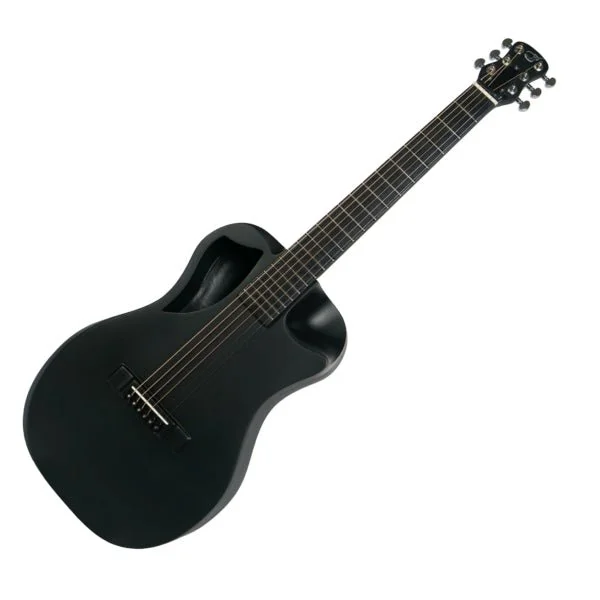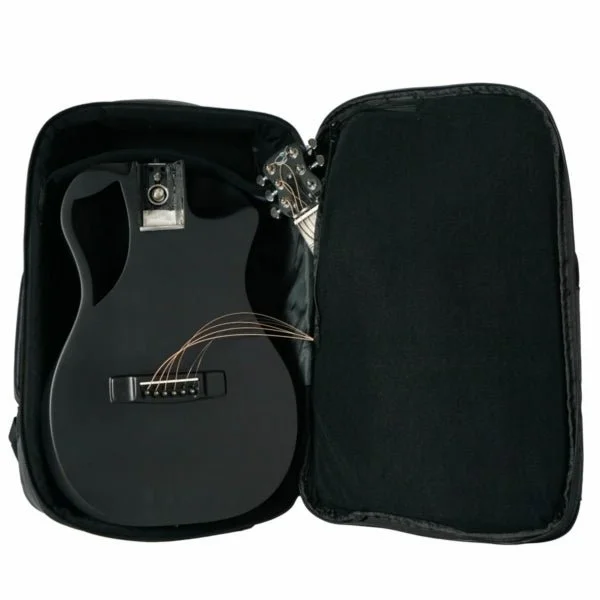Review : Journey OF660M Carbon Fibre Travel Guitar
Hey folks, this is the first of three reviews of Journey Instruments Travel Guitars. I was very surprised when the manufacturer approached me directly to do my unbiased review of their products. I travelled with a guitar to play in hotels for myself for a decade and while my experience was limited to the one that I owned (still do), I get folks asking about travel instruments quite regularly and the company was completely open to a review where they would have no control over the content. I promised that if I ran into issues, I would ask them first. but for the first of three guitars, there have been no issues so here we go.
The OF660M is a travel guitar that comes in an overhead ready nicely padded case, where the guitar is made of carbon fibre weave. I want to start here, because much of what we see as carbon fibre is just injection molded into plastic. That means typically about 6% actual carbon fibre. When a weave is used, the guitar body and in this model the neck are actual sheets of carbon fibre laminated together.
I’m an Ambassador for Emerald Guitars from Ireland and in taking on that voluntary role, I have learned the facts behind high end carbon fibre. I will not say that the OF660M is the same as an Emerald, but we are talking about significantly different price points as well as use cases.
A Travel Guitar
A travel guitar is always going to be a collection of benefits and compromises. It’s going to be compact and transportable, but the offset to that is that it will not be as loud or perhaps as rich in the bottom end. That’s not a materials thing, it’s an acoustics thing. A travel guitar must be built to be able to get small, and that means some engineering to make that happen. Sometimes it means a shorter scale size, particularly since the maximum length of an overhead on an aircraft is already shorter than a common instrument scale length. This can be achieved with a short body, sort of, but then there is a comfort and playability compromise.
Most travel guitars are pickup based because body depth can be another problem relating to both sound and the viability of the neck joint. So some smart engineering is needed there as well if the thing is going to be reliable.
If the neck comes apart as part of the design, when reconnected, it must go back to the same action, string tension and usability every time, It also must provide for rapid tool free assembly and compaction. While these things may sound simple, they really aren’t simple at all.
Thus choosing to build a travel guitar is a decision fraught with challenges that are above and beyond building a compact guitar.
About Journey Instruments
Journey is a US company based in Texas with a building shop located in China. The team is small, but built of folks with massive expertise in their fields. They bring experience in carbon fibre weaves, engineering and hundreds of hours of research specifically focused on travel guitars. For this and the other two reviews, I will be looking at the Overhead Series, although there is a Puddlejumper Series which is collapsible and the Comfort Series which is not.
Travelling
I find it very annoying that what the instrument media refer to as travel guitars really aren’t. They are either ¾ body or small body, short scale options that will engender hostility at the gate at most airports. Having spent more than 3 million miles in the air. I have seen every size and shape of whatever attempt to be stuffed into the overhead bins on everything from full size aircraft to regional turboprops. Clearly many people have not figured out that you cannot fit 9 cubic feet of luggage into 4 cubic feet of constrained space. Most of what I see marketed as travel guitars will take up more space than typically allowed in an overhead and certainly would not fit under an airplane seat. Now if you take air travel out of the travel potential entirely that’s a different conversation, but the Journey Instruments were designed with air travel in mind. And as air travel continually degrades into a bovine boxcar experience with narrower seats, less legroom and less overhead space, those so called travel instruments could end up in the hold. We’ll call that sub-optimal and leave it at that. The Overhead series being reviewed here is built to go in the overhead compartment and not suck up so much space that you end up in a fist fight with a Karen.
The OF660M
I chose to start the review series with the OF660M because it is the most capable of the models and based on the science, also the most stable and enduring. There is a perspective that carbon fibre cannot sound like wood. True, but the real question is how far off is the sound, and do you actually care. In my bigger Emeralds, lots of people have not been able to tell that they are all carbon fibre and in the case of this guitar, I don’t think a person listening to a recorded passage would be able to tell that this was not a small bodied laminated sides and back parlour guitar. You would know it to look at it, but if you didn’t see the guitar and make some assumptions up front, I don’t think you’d know although you might wonder if the recroding engineer had the levels set a bit low if you were doing a side by side comparison. So yes the OF660M is a bit quieter acoustically than a same sized laminated wood guitar, but not by much.
The OF660M is finished in matte black. The outer finishing is super smooth and while I prefer the look of gloss finishes, this matte is very pleasant and very easy to keep clean. The back of the neck is similarly smooth and never gets sticky or gooey. The nut width is between a steel string and a wide classical, so string spacing is very comfortable and even big fingers can get in there easily. The OF660M is a steel string guitar, but for those who want nylon strings there is a nylon string version available called the OC660M. There is a gloss version of the OF660 steel string as well.
The soundhole is on the upper bout, and when you look in, some people have been concerned that the surface looks a bit rough on the inside of the guitar. It is. You find that with a carbon fibre weave. It has no negative impact on the sound at all, and the multiple reflective surfaces should contribute to greater resonance in the body,
The frets are polished nickel silver, the bridge is carbon fibre and the saddle and nut are bone. The fretboard is part of the neck and is carbon fibre. The tuners are Journey branded locking tuners that are smooth and without lash. The factory installed strings are Elixirs.
This guitar includes a three contact sensor passive piezo pickup system that looks a lot like a K&K Pure Mini to me, but is most likely a clone of the well established K&K. Passive means no battery, but you will then want some way to control the output gain, either with a strap mounted preamp, or a volume pedal on the floor. To record, I ran the guitar directly into a Clarett 8+Pre and then chose a channel strip that I liked to deal with any piezo issues, The output uses a standard mono guitar cable.
The Overhead case is built specifically to hold the guitar when disassembled and is nicely padded and semi rigid, It has space for the guitar, some accessories like a tuner and capo as well as cables. There is a built in laptop sleeve that will hold a 14” laptop.
Assembly and Disassembly
The photo of the OF660M in the case shows that the strings don’t come off for travel. You detune the strings and follow the simple steps to remove the neck before putting it in the case. When you are ready to reassembly you reverse the process. The first time I did it, it took me about two minutes. Now that I know what I am doing, it is quicker. You don’t need all kinds of strength, endurance or agility but do make sure the strings are detuned to make the job easier.
Journey includes a printed Quick Start Guide page, and I have reproduced it here.
If the QSG makes it look incredibly easy, that’s because it is incredibly easy. What I really appreciate is that if you follow the instructions and tighten up the neck bolt, the action is nice and low and there is no fretting out. The truss rod is fully adjustable although I like carbon fibre because it is so darn stable.
While the Carbon Fibre models are the most expensive, I recommend carbon fibre if you can make it work. Travel guitars by their nature move around a lot and have to deal with variances in humidity and in temperature. more than any other kind of guitar. When travelling I don’t want to have to do adjustments for every different location. If you go camping, it’s a perfect material. Robust, lightweight to carry and doesn’t care about the weather. Want to play and sing around a campfire? Go for it. The other benefit to the carbon fibre acoustic body is that other than a tuner, and whatever you pick with, you really don’t need to carry anything else.
As the rear strap pin is also the output jack you run into the same problem as you find with all these things. My solution is an adapter from Music Nomad called the Acousti-Lok. I’ve written about them here. You remove the factory end cap and replace it with the Acousti-Lok. Now you have an endpin jack that is separate from a standard sized strap lug. Do you have to do this? No. But I always do, because I always use a strap.
Playability
I entered this without any expectations. While I own Steinberger headless travel instruments, I didn’t bring those experiences to the OF660M. The neck bolted up easily where the biggest challenge was making sure that I didn’t wrap the strings around themselves. If you follow the instructions, you have to work hard to screw things up. I tightened up the neck lock and then did the leg brace thing as in the document and got some more turns on the neck lock. This resulted in an action of about 2.2mm on the low E at the 12th. No rocking frets and the lower front cutaway does allow one to play up the neck.
One of my core tests of factory setup is whether it is simple to play an F barre chord at first position without massive hand strength. Piece of cake.
The small body would be brighter, but Journey has engineered the guitar to not get all nasal sounding and I found that by varying pick hand placement, I got a nice wide range of tones from bright to deep and warm. The factory Elixirs are decent strings and while I would change them out if it were my guitar, the instrument is ready to play as it arrives.
The built in pickups sound just fine and as the contacts are place in body and not just under the saddle, the tonal range is quite good. Being not a lover of piezos, I would use an external preamp, or decent acoustic amp if needed, or run into an interface and use a channel strip but I can be a bit picky and believe that saner folks would be happy just the way the guitar comes.
Example Sounds
To get some quick samples of the sound of the guitar, I used its built in pickup system direct into a Clarett+ 8 Pre which feeds Logic Pro. I recorded the guitar completely dry, using the input level control on the Clarett to set my recording level. Once I had the basic track down, I then tried versions using different channel strips to determine what I liked best. In my preparation, I plugged the guitar directly into a LANEY A Series DUO and a AER Compact 60. Both have their own preamps and as usual, I prefer a preamp used with any piezo based acoustic guitar.
I played the progression and as noted recorded it raw. That’s the first pass. The second uses an Abbey Road TG12345 Channel Strip and a Fairchild 670 compressor. The third uses a UA LA-6176 Channel Strip. All are finalized with a Brainworx Masterdesk.
It is my contention that this small, massively portable guitar sounds great and will serve any person looking for a great playing, great sounding, easy to travel guitar.
I have played other acoustic travel guitars. My first experience was with Martin’s Backpacker. The Backpacker looks more like a stick than a guitar but when it came out, it was the one to choose, although I never liked the sound. I found it lacking in the low mids and having no bass and did not like the neck. It felt to me then, and still does, like a low end guitar with a very expensive decal.
I own a Baby Taylor that I won at a Taylor event. I gave it to my daughter because it suits her playing activity and space considerations better. It would be tough to stuff it in an overhead compartment and while it is quite a bit less expensive than the Journey wood acoustics, is not a joy to play and the visible wood screws that hold the neck on from the front just cheapen the look.
Thus for me, the Journey is a far superior choice. Yes the carbon fibre makes it more expensive, but I don’t feel like I am losing much in tone, even with the small body, and it is a far better playing experience than anything else that I have had the opportunity to try.
Wrapping Up
Journey guitars are available from select retailers and also online directly. Advertised prices are the same everywhere. The Journey Canada store shows the OF660M complete with case for $2205.99 CAD which considering that it is a real carbon fibre weave build is quite reasonable. That model is available in matte black, blue purple colour shift gloss, orange matte and blue matte at the same price. A pearl white is $2283.99 and the gloss black is the same price as the white. The black matte nylon string version is alos $2205.99
The materials and components are excellent and you definitely paying for the carbon fibre body and neck in this guitar. If that’s outside your comfort zone, come back for the next two weeks where I will be reviewing a wooden body acoustic and a solid wood electric. If you are seeking an ideal travel guitar that will never be impacted by temperature or humidity, get yourself one of the OF660 models.
If you like what I do here for you, please become a supporter on Patreon. Your monthly contribution makes an enormous difference and helps me keep things going. To become a Patreon Patron, just click the link or the button below. Always feel comfortable to send in a question or to post a comment. I read them all and respond as appropriate. Thanks for your support of my work. I’m Ross Chevalier and I look forward to sharing with you again soon.




